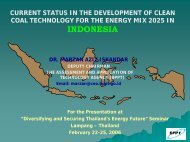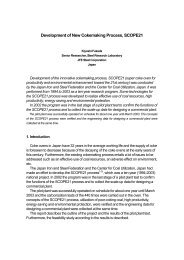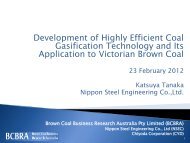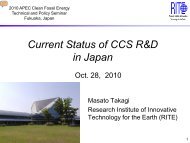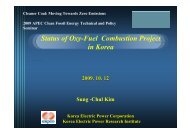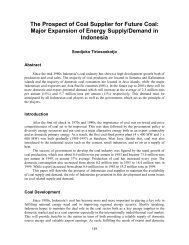Defining CCS Ready: An Approach to An International Definition
Defining CCS Ready: An Approach to An International Definition
Defining CCS Ready: An Approach to An International Definition
- No tags were found...
Create successful ePaper yourself
Turn your PDF publications into a flip-book with our unique Google optimized e-Paper software.
Appendix C: Policy Considerations and Assessments of <strong>CCS</strong> <strong>Ready</strong> Economicsprice may not be a full measure of retrofit economics and so the increase <strong>to</strong> net presentvalue of the plant is used as the criteria for the retrofit decision.C.4.3 Estimates for a General GHG Policy and Cost of GHG EmissionsThe probability distributions of some of the key inputs for the Base Case are shown in ExhibitC-2. All prices are in real U.S. dollars. One of the most important inputs is the year in whichgeneral GHG restrictions come in<strong>to</strong> force. Assumptions for this parameter must be made bypolicymakers based on their best judgement of the likely outcome of political and regula<strong>to</strong>ryprocesses in their own jurisdictions. For theBase Case illustration for a new coal-fired USpower plant, GHG restrictions are assumed<strong>to</strong> begin as early as year 2016, with a 10%probability of beginning in that year. Thecumulative probability of GHG restrictiongoes up in each successive year, reaching100% in 2025. This cumulative probabilitydistribution for the start date of GHGrestrictions is shown as the in the first char<strong>to</strong>n the second row of Exhibit C-2.Examples of Computer Models That<strong>An</strong>alyse GHG Policies and Economics• Integrated Planning Model (IPM)-Plus, ICF <strong>International</strong>• Emissions Predictions and Policy <strong>An</strong>alysis (EPPA) Model(EPPA), MIT• Applied Dynamic <strong>An</strong>alysis of the Global Economy (ADAGE)Model, RTI <strong>International</strong>• Mini-Climate Assessment Model (MiniCAM), Joint GlobalChange Research Institute (PNNL)• MARKAL, Brookhaven National LabThe cost of emitting one metric <strong>to</strong>n of CO 2 (this can be interpreted as the expected valueof an allowance price under a cap and trade system or as a CO 2 tax) is assumed <strong>to</strong> start atabout $12/metric <strong>to</strong>n in the first year of restrictions, reach $30/metric <strong>to</strong>n about 15 yearslater and continue <strong>to</strong> rise <strong>to</strong> $150/metric <strong>to</strong>n after about 40 years. For the Base Case theexpected value of allowances is $21.77/metric <strong>to</strong>n in 2030 and $102.64/metric <strong>to</strong>n in 2050.The probability distribution for allowance prices in those two years is shown in the secondchart on the second row of Exhibit C-2. The assumptions for the range of allowances priceswould typically be determined by policymakers through analysis of computer models thatanalyse energy supply and demand and GHG policies and economics. One such model isICF’s IPM-Plus. This model and examples of other models are listed in the text box above.C.4.4 Estimates for Future Fuel and Electricity PricesIn the Monte Carlo analysis the price of fuels and electricity should be drawn fromdistributions that maintain a logical relationship among all prices. Most US regions havewholesale electricity prices which are determined for most hours in the year by the dispatchcosts of marginal natural gas-fired power plants. Therefore, in the Monte Carlo analysis theelectricity prices are modelled primarily as a function of natural gas prices with additionalinfluences from allowance prices, coal prices and a random variable representing otherelectricity market fac<strong>to</strong>rs. For the Base Case illustration, in the year 2030 the expectedvalue of natural gas prices are about $7.50 per MMBtu and those of coal are $1.90 perMMBtu. In the year 2050 the expected value of natural gas prices are about $9.00 perMMBtu and those of coal are $2.10 per MMBtu. These fuel prices are stated before anyGHG allowance related <strong>to</strong> their use is fac<strong>to</strong>red in. The distributions for natural gas and coalprices are shown for the year 2030 and 2050 in the first row of Exhibit C-2.The new power plant is assumed <strong>to</strong> have revenues based on the prevailing wholesaleelectricity prices and the number of hours it can be dispatched given those prices and thevariable cost of dispatch (fuel costs plus variable O&M plus GHG allowance cost). The off-23 February 2010 109



